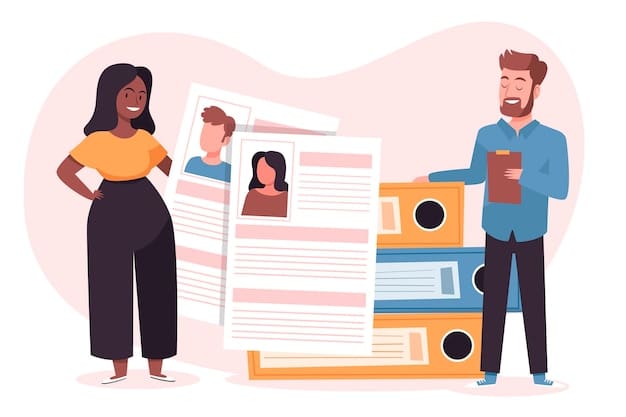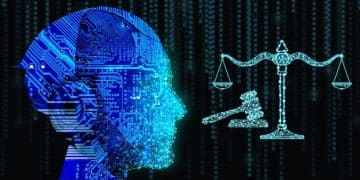AI Hiring: Mitigating Bias for Fair Employment in the US

AI-driven hiring tools offer efficiency but can perpetuate bias; thus, understanding their ethical implications and implementing strategies to ensure fairness in employment practices within the US is crucial.
In today’s rapidly evolving job market, AI-driven hiring tools are increasingly being adopted by companies across the United States. While these technologies promise efficiency and objectivity, they also present a significant risk: the perpetuation of bias, which can undermine fair employment practices.
Understanding AI-Driven Hiring Tools
AI-driven hiring tools are reshaping how companies identify, screen, and select candidates. This transformation offers opportunities for efficiency but also raises concerns about embedded biases.
These systems leverage algorithms and machine learning to automate various stages of the hiring process, from resume screening to initial interviews.
The Functionality of AI Hiring Systems
AI hiring systems analyze data to identify patterns and predict candidate success. However, if the data used to train these systems reflects existing societal biases, the AI will likely perpetuate and even amplify those biases.
- Resume Screening: AI algorithms scan resumes for keywords, skills, and experience, ranking candidates based on pre-defined criteria.
- Automated Interviews: Chatbots or video analysis tools conduct initial interviews, assessing candidates based on their responses, facial expressions, and tone of voice.
- Skills Assessments: AI-powered platforms evaluate candidates’ skills through tests and simulations, providing objective measures of their abilities.

Understanding the types of AI tools used in hiring is essential for identifying and mitigating potential biases. By ensuring transparency and accountability, organizations can harness the benefits of AI while upholding fair employment practices.
Identifying Bias in AI Hiring Processes
Bias in AI hiring processes can manifest in several forms, leading to unfair discrimination against certain groups of candidates. Recognizing these biases is the first step toward creating more equitable hiring practices.
AI systems learn from data, and if that data is skewed, the system will reproduce and amplify those biases, reinforcing existing inequalities.
Sources of Bias in AI Hiring
Bias can creep into AI hiring systems through various sources, including biased training data, flawed algorithms, and subjective evaluation criteria.
- Historical Data: If historical hiring data reflects past discriminatory practices, the AI will learn to replicate those practices.
- Algorithm Design: Algorithms can be inherently biased due to the assumptions and preferences of their creators.
- Data Interpretation: The way AI interprets and analyzes data can also introduce bias, particularly if the system relies on stereotypes or assumptions.
To mitigate bias, organizations must critically evaluate their hiring processes, scrutinize the data used to train AI systems, and regularly audit the outcomes to ensure fairness and equity in hiring decisions.

Legal Framework for Fair Employment in the US
The US legal framework provides a foundation for fair employment practices, protecting job applicants from discrimination based on various protected characteristics. AI-driven hiring tools must comply with these laws to avoid legal liabilities.
Understanding and adhering to these laws is crucial for organizations using AI in hiring to ensure they are not inadvertently violating federal and state regulations.
Key US Employment Laws
Several federal laws prohibit discrimination in employment, including Title VII of the Civil Rights Act, the Age Discrimination in Employment Act (ADEA), and the Americans with Disabilities Act (ADA).
- Title VII: Prohibits discrimination based on race, color, religion, sex, or national origin.
- ADEA: Protects individuals aged 40 and older from age-based discrimination.
- ADA: Prohibits discrimination against qualified individuals with disabilities.
Organizations must ensure that their AI hiring tools do not have a disparate impact on protected groups. Regular audits and validation can help identify and mitigate any discriminatory effects of AI-driven hiring processes.
Strategies for Mitigating Bias in AI Hiring
Mitigating bias in AI hiring requires a multi-faceted approach that addresses data quality, algorithm design, and ongoing monitoring. By implementing these strategies, organizations can ensure their AI systems promote fairness and equity.
A proactive approach to bias mitigation can help organizations unlock the full potential of AI while upholding their commitment to diversity and inclusion.
Best Practices for Bias Mitigation
Implementing best practices for bias mitigation involves several key steps, from data collection to algorithm validation. These practices ensure that AI systems are fair, transparent, and accountable.
- Diversify Training Data: Use diverse and representative data sets to train AI systems, ensuring that they reflect the demographics of the applicant pool.
- Blind Resumes: Remove identifying information from resumes to prevent unconscious bias from influencing hiring decisions.
- Regular Audits: Conduct regular audits of AI systems to identify and address any discriminatory patterns or outcomes.
By adopting these strategies, organizations can minimize the risk of bias in AI hiring and create more inclusive and equitable workplaces.
Ensuring Transparency and Explainability
Transparency and explainability are essential for building trust in AI hiring tools. When candidates understand how AI systems work and how decisions are made, they are more likely to accept and trust the process.
Transparency in AI hiring systems can foster greater confidence among job applicants.
The Importance of Explainable AI (XAI)
Explainable AI (XAI) refers to AI systems that can provide clear and understandable explanations for their decisions. This is particularly important in hiring, where candidates need to understand why they were or were not selected for a position.
* **Model Interpretability:** Use AI models that are inherently interpretable, such as decision trees or linear models, rather than complex neural networks.
* **Decision Justifications:** Provide candidates with explanations for why they were ranked in a particular way or why they were rejected.
* **Audit Trails:** Maintain detailed records of all AI-driven hiring decisions, including the data used, the algorithms applied, and the rationale behind each decision.
Enhancing transparency and explainability not only promotes fairness but also helps organizations meet regulatory requirements and build a positive reputation as an employer.
Future Trends in AI and Fair Employment
The future of AI in hiring is likely to be shaped by ongoing technological advancements and evolving regulatory standards. Staying informed about these trends is essential for organizations to remain at the forefront of fair and effective hiring practices.
As AI technologies continue to evolve, organizations must adapt their practices to ensure they are leveraging AI responsibly and ethically.
Emerging Technologies and Regulations
Several emerging technologies and regulatory trends are expected to influence the future of AI in hiring.
* **Advanced AI Models:** Development of more sophisticated AI models that can better account for and mitigate bias.
* **AI Ethics Frameworks:** Growing adoption of AI ethics frameworks that provide guidelines for responsible AI development and deployment.
* **Increased Regulatory Scrutiny:** Increased regulatory scrutiny of AI hiring tools to ensure compliance with fair employment laws.
| Key Point | Brief Description |
|---|---|
| 🤖 Understanding AI Hiring | AI tools transform hiring, but biases must be addressed. |
| ⚖️ Legal Compliance | Adhering to US fair employment laws is crucial for legal AI use. |
| 🛡️ Mitigating Bias | Strategies like diverse data and regular audits reduce AI bias. |
| 🔎 Transparency in AI | Explainability builds trust by clarifying AI hiring decisions. |
FAQ
▼
AI-driven hiring tools use algorithms to automate aspects of recruitment, like screening resumes and conducting interviews. They aim to improve efficiency by identifying top candidates.
▼
AI systems learn from data, so biased historical data can lead to AI replicating discriminatory patterns. This results in unfair assessments and skewed hiring decisions.
▼
Title VII, ADEA, and ADA prohibit discrimination based on race, age, disability, etc. AI hiring tools must comply with these laws to ensure fair employment practices.
▼
Diversifying training data, blinding resumes, and conducting regular audits are effective in reducing AI bias. These measures promote equitable hiring outcomes.
▼
Explainability builds trust by showing how AI reaches decisions. Candidates gain confidence when they understand the rationale behind hiring results from AI systems.
Conclusion
In conclusion, while AI-driven hiring tools offer tremendous potential for streamlining recruitment processes, it is essential to proactively address and mitigate the risk of bias. By focusing on diverse data, transparent algorithms, and vigilant monitoring, organizations can ensure that AI enhances, rather than undermines, fair employment practices and legal compliance in the US.





